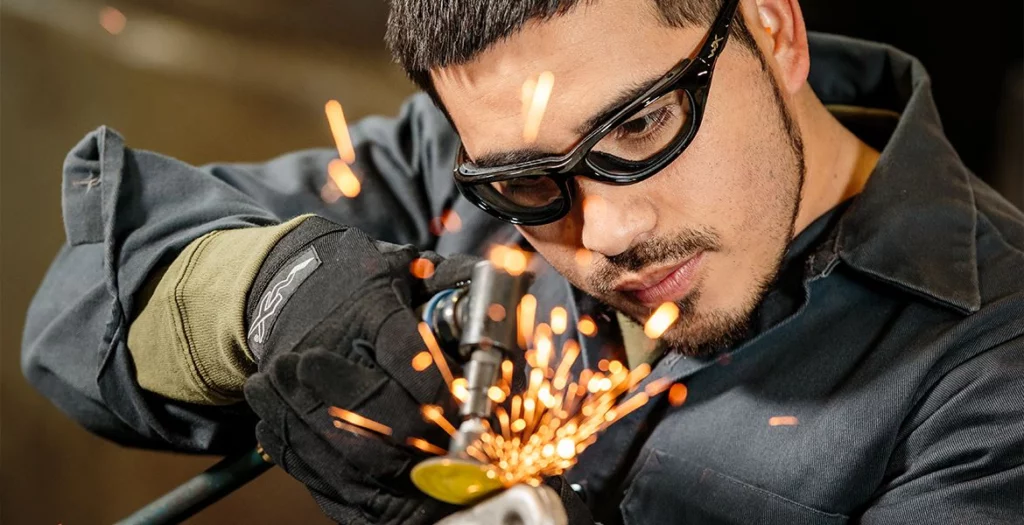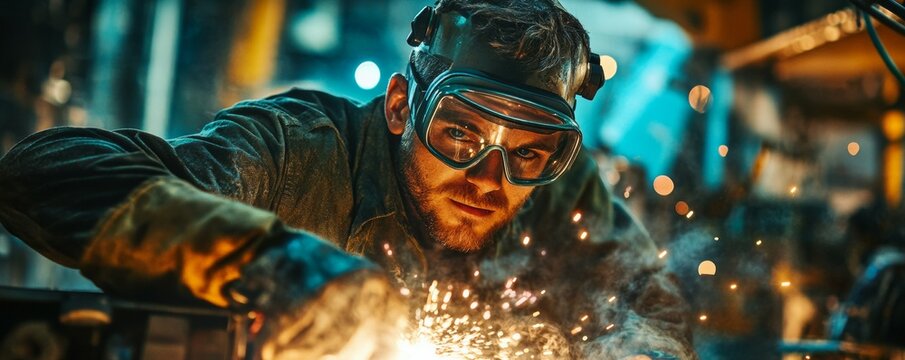Selecting the right welding shades and goggles is key to both your safety and visibility while welding. This guide will provide you with the essential information to confidently choose the perfect eyewear for your needs. By the end of this article, you’ll understand how to pick the ideal welding shade based on your specific tasks and welding processes.
We’ll walk you through the different shade numbers, how to choose the right goggles with features like auto-darkening filters, and how to maintain them for long-lasting performance. Additionally, we’ll explore complementary safety gear to ensure complete protection during your work.
For a broader perspective on selecting welding glasses, check out our main article “How To Choose The Right Welding Glasses – A Buyer’s Guide”.
With our expertise, you’ll be equipped to make the best choice for your welding safety.
Why Are Welding Shades Important?
Welding processes generate various light intensities and radiation, which welding shades effectively shield against. Proper welding shades shield your eyes effectively, ensuring long-term visual health and comfort. Welding shades are essential because they:
- Welding shades safeguard your eyes, enabling you to work comfortably and confidently.
- Enhance visibility for precise welding tasks.
- Reduce glare and strain during extended work sessions.
With the right welding shades, you can enjoy clear vision and sustained comfort during welding tasks.
Understanding Welding Shade Numbers
Welding shade numbers indicate the darkness level of the lens, which is critical for protecting your eyes from varying intensities of light and radiation during different welding tasks. Higher numbers correspond to darker lenses, suitable for more intense light sources. According to the European EN 379 standard:
- Shade 5: Ideal for torch soldering or cutting.
- Shades 8-10: Suitable for light-duty welding, such as MIG welding with low amperage.
- Shades 11-13: Recommended for heavy-duty welding, such as TIG or arc welding at high amperage.
For a more detailed breakdown, see this guide on welding shades.
How to Choose the Right Welding Shade for Your Task

Choosing the correct shade depends on the type of welding you perform and the amperage used. Use the chart below for reference to match your welding task with the appropriate shade number, ensuring optimal safety and visibility.
| Welding Process | Amperage Range | Recommended Shade |
| Gas welding | 20-40 A | 5 |
| MIG welding | 50-200 A | 9-11 |
| TIG welding | 50-300 A | 10-13 |
| Plasma cutting | 20-300 A | 9-12 |
| Arc welding | 100-400 A | 11-13 |
For more about differentiating shades, visit this article.
Shade for Arc vs Gas Welding
When choosing a welding shade, it’s essential to consider the type of welding you’re performing, as shade for arc vs gas welding can differ significantly. Here’s how:
- Arc Welding (e.g., Stick or TIG): Arc welding produces a more intense light and radiation. Therefore, it requires higher shade numbers to protect your eyes. For most arc welding applications, shades 11-13 are recommended, especially when working with high amperage.
- Gas Welding (e.g., Oxy-Acetylene Welding): Gas welding generates lower levels of light intensity compared to arc welding. For this type of welding, you can use a lighter shade. A shade 5 is often sufficient for torch soldering or cutting, as the light is less intense compared to arc welding.
By selecting the appropriate shade, you can ensure both protection and visibility, helping you to work efficiently while keeping your eyes safe.
Features to Look for in Welding Goggles
When selecting welding goggles, consider these features:
- Adjustable Shade Levels: Modern goggles offer auto-darkening filters that adjust shade levels automatically.
- Comfortable Fit: Ensure a snug fit to prevent light leakage while maintaining comfort for extended use.
- Durability: Look for goggles with high-impact resistance to protect against debris.
- Compliance with Standards: Choose goggles certified under EN 166 and EN 379 standards.
Visit our welding goggles collection for a curated selection of goggles featuring adjustable shades, enhanced comfort, and compliance with European safety standards.
Enhancing Safety with Additional PPE
While welding goggles are vital, other protective gear complements eye protection:
- Welding Gloves: Safeguard hands from heat and sparks.
- Welding Helmets: Provide full-face protection and often include adjustable shades.
- Fire-Retardant Jackets: Allow safe work near intense heat.
- Fire-Retardant Gloves: Offer enhanced resistance against heat and flames.
These PPE items enhance your comfort and allow for safe, efficient welding.
Key Considerations for European Standards
In Europe, welding safety gear must meet specific standards:
- EN 166: Covers general eye protection.
- EN 379: Defines auto-darkening welding filters.
Certified goggles deliver reliable protection and performance, allowing you to meet safety standards confidently.
Tips for Maintaining Your Welding Goggles
To maximize the lifespan and performance of your goggles:
- Clean Regularly: Use a soft cloth and lens cleaner to remove debris and smudges.
- Store Properly: Keep goggles in a protective case to avoid scratches.
- Inspect Frequently: Routine inspections help ensure your goggles are always in top condition for optimal performance.
Related Resources
For further guidance, explore these articles:
- How To Choose Safety Glasses – A Buyer’s Guide
- Welding Helmets: Everything You Need To Know
- How To Choose The Right Face Shields – A Buyer’s Guide
These resources provide insights into selecting comprehensive PPE for various applications.
Conclusion
We hope this guide has provided you with valuable insights into selecting the right welding shades and goggles, from understanding shade numbers to ensuring proper fit and durability. Whether you’re working with MIG, TIG, or arc welding, we’re here to support your safety and performance needs.
Explore our welding goggles collection, featuring trusted brands that offer the protection and quality you need for every job.
For more in-depth advice, don’t miss “How To Choose The Right Welding Glasses – A Buyer’s Guide”.
Have questions or need help choosing the perfect goggles? Don’t hesitate to reach out—we’re always here to assist you in making informed decisions for your safety and comfort.
– The Droppe Team
Frequently Asked Questions
Auto-darkening goggles adjust the lens shade automatically based on the light intensity, while fixed lenses have a constant shade level.
Your goggles should fit snugly around your eyes without gaps, providing full coverage and comfort for extended use.
It depends on the shade level. Lighter shades are suitable for lower amperage tasks, while higher shades are needed for more intense welding.
Replace your goggles if the lens becomes scratched, cracked, or damaged, or if they no longer provide adequate protection.
Yes, some goggles are designed for outdoor use, offering additional protection against sunlight and reflections. Indoor goggles typically focus more on the welding light intensity.

















